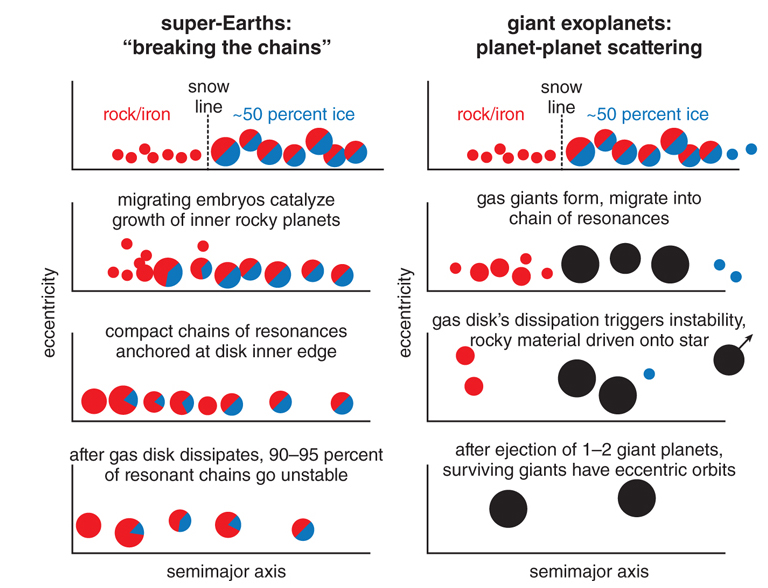Sculpting Our Planetary System
By Sean Raymond
Our Solar System is a rarity in the universe
Our Solar System is a rarity in the universe

The discovery of thousands of planets orbiting other stars has given us three surprising insights about our Solar System. First, we are weird: Our Solar System is a 1-in-2,000 rarity. Second, planet formation is a dynamic process, characterized by large-scale orbital drift as well as violent collisions and the ejection of young planets into interstellar space. Lastly, the second point may explain the first one—that is, how our Solar System formed is likely the root cause of our weirdness.
My job is to understand how planets form. This is no easy task, given that we live in such an oddball system. But computer models are improving their ability to realistically simulate the growth of planetary systems. A picture is emerging—albeit a still incomplete one—of how planets form in a larger, galactic context. Simulations show that small divergences at key stages in planets’ growth can lead to dramatic differences in fully formed systems. Our system’s structure holds clues about which path it followed at critical junctions.

Illustration courtesy of Hagai Perets, Technion
Within disks of gas and dust swirling around young stars, planetary researchers think the story goes as follows: Dust grains grow into pebbles. Pebbles drift through the disk and clump into 100-kilometer-scale planetesimals, or asteroidlike objects. Planetesimals and more drifting pebbles then grow into planetary embryos with a mass equal to or greater than that of Mars.
A massive embryo launches density waves that exchange angular momentum with the gaseous disk, causing the embryo’s orbit to shrink (or, more rarely, to grow) in a process called migration. Some particularly large embryos capture great quantities of gas and become giant planets. A few million years later, the gas in the disk dissipates, which in most systems triggers a phase of instability. Growing rocky planets may undergo giant collisions, such as the impact that formed our Moon. Instabilities among giant planets are even more extreme, usually culminating in the ejection of one or more planets into interstellar space.
To fit all the pieces together, we need to understand the interconnections between the different phases of planetary growth, at various times and places and on different size scales. For a long time, astronomers assumed that planets just plopped together in place; now we know that is not even close to being true. We think that the key processes just described—orbital migration and dynamical instability—are the disruptive architects of planetary systems.
When we survey the population of exoplanets, super-Earths (with masses that fall between that of Earth and that of Neptune) are the most common type we see: About half of all stars have a super-Earth orbiting them, circling them more closely than Mercury does the Sun. The equivalent region of our Solar System is completely empty. How did all those super-Earths get there?
Migration generally causes the orbits of planetary embryos to shrink, so it is natural to imagine that migration may have played a role. Let’s assume that the building blocks of super-Earth systems are similar to those that formed the Solar System, with small, rocky embryos populating the inner region and large embryos forming past the snow line, the boundary beyond which temperatures are cold enough that ice could be used as a building block. Large embryos might migrate inward to the inner edge of the disk, which acts as a migration trap.
Our models show that successive migrating embryos do not collide but are driven into orbital resonances, in which the orbital periods of adjacent planets form ratios of small integers. For example, in 3:2 resonance the outer planet completes two orbits in the time it takes the inner planet to complete three. Migration naturally generates chains in which each pair of neighboring planets is in resonance, stabilized in part by the gaseous disk. When the gas dissipates, the chains break, but sometimes the orbital patterns persist after the gas disappears. Several examples of such resonant systems have been discovered, such as the TRAPPIST-1 system, which hosts seven tightly spaced Earth-sized planets.

Image courtesy of the author.
The “breaking the (resonant) chains” model matches the measured properties of the super-Earth population. Giant exoplanets appear to fit this model as well. They are commonly found on stretched-out, eccentric orbits. In these systems, multiple gas giants probably originally formed in circular orbits. Embedded in their gaseous disks, they migrated into resonances. Upon dispersal of the gas disk, the resonant systems became unstable, leading to planet-planet scattering and the ejection of one or more planets. The surviving planets ended up on eccentric orbits, the scars from their systems’ violent pasts.
Although our Solar System is unusual, it bears its own scars from a violent past. The configuration of the familiar planets makes more sense when seen in the context of these new models.
Several lines of evidence point to an instability in the orbits of the giant planets, which would have been naturally triggered if they had migrated into a resonant chain. For decades, studies of planet formation were plagued by the small Mars problem. The classical model of planet formation assumes that the terrestrial planets (Mercury, Venus, Earth, and Mars) grew from a disk of planetary embryos and planetesimals that extended from Mercury’s orbit out to Jupiter’s. Yet simulations of that model systematically produce a Mars that is as massive as Earth, an order of magnitude larger than the real Mars.
Three solutions have been proposed to the small Mars problem. The Grand Tack model, developed in 2011 by my colleagues and I at the Observatoire de la CÔte d’Azur in Nice and the Laboratoire d’Astrophysique de Bordeaux, proposes that Jupiter migrated inward and then outward, clearing much of the rocky material from the Mars region. The asteroid belt was emptied and then refilled by the migrating Jupiter. The Low-mass Asteroid Belt model, spearheaded by researchers at the University of California, Los Angeles, and the University of Zurich, assumes that planetesimals formed in a narrow ring between the present-day orbits of Venus and Earth, with almost none in the asteroid belt. In this model Mars represents an embryo kicked out of the ring and starved. Finally, the Early Instability model, developed in 2018 at the University of Oklahoma, holds that the giant planets’ instability happened shortly after dispersal of the gaseous disk, depleting the Mars region but not the Earth-Venus zone.
Each model matches the terrestrial planets’ masses, orbits, and inferred formation timescales, as well as the observed structure of the asteroid belt. Yet each has a potential Achilles’ heel. For the Grand Tack model, it’s unclear whether Jupiter’s outward migration is viable within realistic disks and formation scenarios. For the Low-mass Asteroid Belt model, it’s unclear whether rings of planetesimals really form. For the Early Instability model, we don’t know enough about the timing of the Solar System’s instability. Using all resources available, from exoplanet studies to meteorite analyses to computer simulations, the next steps are to figure out which of these models may represent our system’s true past.
Even now, we can start to piece together the formative events that made our Solar System weird. Jupiter must have grown quickly and starved the inner Solar System, blocking inward-drifting pebbles to prevent the terrestrial embryos from growing massive enough to migrate. Later, Jupiter blocked the inward migration of Uranus and Neptune, which can be thought of as failed super-Earths. But Jupiter’s migration cannot have brought it too close to the terrestrial planet region, or else Earth’s growth would have been violently disrupted; perhaps, as in the Grand Tack model, Jupiter was held back by Saturn’s presence. Similarly, Jupiter’s instability could not have been too strong. According to our models, the instability involved strong gravitational scattering between Jupiter and an ice giant (a sibling of Uranus and Neptune that later was ejected), but Saturn and Jupiter never scattered off of each other. Earth would not have survived if they had.
What all the models tell us is that planetary formation is a dynamic process, marked by big instabilities and lurching movements. No wonder there is such a dizzying array of systems out there. We’ve long wondered whether the Earth is normal or an oddball. The answer is, it is both. The processes shaping our Solar System were commonplace, but the outcome was unusual. Still unknown: Is the Solar System unique?
Click "American Scientist" to access home page
American Scientist Comments and Discussion
To discuss our articles or comment on them, please share them and tag American Scientist on social media platforms. Here are links to our profiles on Twitter, Facebook, and LinkedIn.
If we re-share your post, we will moderate comments/discussion following our comments policy.